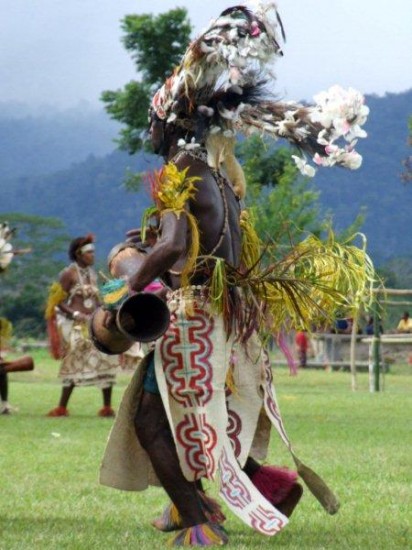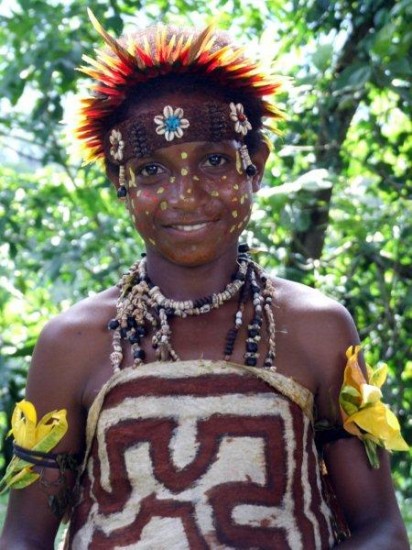Nests of long, slender bird-of-paradise plumes sway on bobbing heads above painted faces streaked in yellow, red and black. Kari shell vests tinkle in the tide of sound and boars’ tusk grins leer from decorated mouthpieces.

A young Koiari warrior proudly displays the trappings of his clan, National Fuzzy Wuzzy Day 2011 at Kokoda, Papua New Guinea (c) Vincent Ross.
It is a scene the ancient razorback ridges of the Owen Stanley Ranges of Papua New Guinea have witnessed countless times over the centuries as the sound of kundu drums thump through the green cathedral of the surrounding jungle. Through dancers’ the movements, the vibrancy of life pays homage to the mystery of death.

A Koiari dance troupe poses for the camera, National Fuzzy Wuzzy Day 2011 at Kokoda, Papua New Guinea (c) Vincent Ross.
But in recent years it has become significant. In early November, the people of the Owen Stanleys gathered at Kokoda to mark the 70th anniversary of the ending of the Kokoda Campaign in World War II.

Koiari boy and kundu drum, National Fuzzy Wuzzy Day 2011 at Kokoda, Papua New Guinea (c) Vincent Ross.
In previous years, it has been called Kokoda Day, but two years ago the PNG government initiated National Fuzzy Wuzzy Day, to commemorate not only the Australian soldiers who fought and died on the track, but the native porters who helped them.
On November 2, 1942, advanced scouts from the Australian Army’s Maroubra Force entered the Kokoda Government Station, discovering that the Japanese had retreated. By evening Kokoda was occupied by the battalion. The next day, members of the Australian 25th Brigade stood in silence at a memorial service followed by a flag-raising ceremony in which General George Vasey marked the recapture of Kokoda after three months of bitter fighting.
Held in Kokoda on November 3, National Fuzzy Wuzzy Day celebrations were a mass of feathers, face paint and possum fur cloaks as the locals gather for this special Sing Sing.

Fine feathered friend; a Koiari warrior in full headdress, National Fuzzy Wuzzy Day 2011 at Kokoda, Papua New Guinea (c) Vincent Ross.
The Koiari are proud of their forefathers, the Fuzzy Wuzzy Angels who were amongst the more than 50,000 tribesmen who worked as porters for the Australian Army in Papua New Guinea during World War II. The “angels” helped stretcher out wounded Australian soldiers over countless kilometres of steep, muddy, slippery track.
In the week leading up to November 3, Koiari villagers, families and clan groups walked the rugged Owen Stanleys, sometimes for days, to reach Kokoda for the commemoration ceremony, dancing and sporting events. The Australian and Papua New Guinea flags were raised in a sombre memorial service followed by a re-enactment of Fuzzy Wuzzy Angels carrying the wounded in stretchers made with blankets and sapling poles cut from the jungle, lashed together with vines.

A Koiari woman and her child watch the dancers, National Fuzzy Wuzzy Day 2011 at Kokoda, Papua New Guinea (c) Vincent Ross.
The dancing took place on Kokoda’s oval, perched on the edge of a small, grassy plateau, less than 50 metres from the now-collapsed trenches desperately dug by the Australian militiamen of the 39th Battalion in July, 1942.
The dancers are crowned in spectacular headdresses, their faces painted in a rainbow of colours, their oiled bodies decorated with tropical flowers and draped in necklaces and vests of kari shells.
Continues soon in: Kokoda Part 2: A Living Memorial
Photo Credits
All Photos © Vincent Ross – All Rights Reserved




[…] Continued from: Kokoda Part 1: The Legacy of Kokoda […]